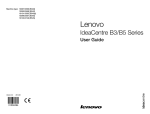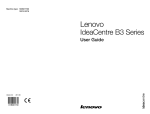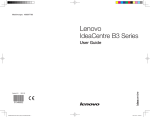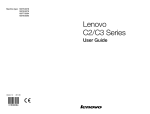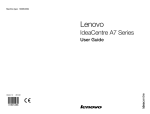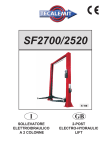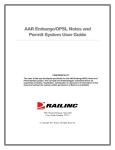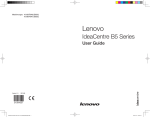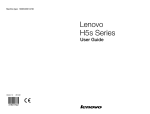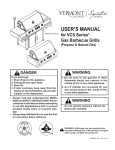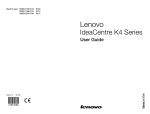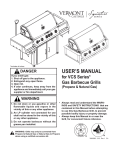Download Lenovo IdeaCentre B540
Transcript
Machine type: 10097/2566 [B340] 10099/2568 [B540] 10101/3363 [B540p] 10098/2567 [B345] 10100/4749 [B545] Lenovo IdeaCentre B3/B5 Series User Guide Version 1.0 2012.02 31501557 Important Safety Information Before using this manual, it is important that you read and understand all of the related safety information for this product. Refer to the Safety and Warranty Guide that you received with this product for the latest safety information. Reading and understanding this safety information reduces the risk of personal injury or damage to your product. The interface and functions shown in this User Guide are provided for reference only and may differ from actual product appearance. Product design and specifications may be changed without notice. Danger: Be aware of extremely hazardous or potentially lethal situations. Attention: Be aware of possible damage to programs, devices, or data. Note: Pay attention to this important information. © Copyright Lenovo 2012. All rights reserved. LIMITED AND RESTRICTED RIGHTS NOTICE: If data or software is delivered pursuant a General Services Administration “GSA” contract, use, reproduction, or disclosure is subject to restrictions set forth in Contract No. GS-35F-05925. © 2012. Lenovo Contents Important Safety Information Chapter 1 Using the Computer Hardware............................... 1 1.1Front view of the computer.......................................................2 1.2Left and right view of the computer..........................................3 1.3Rear view of the computer........................................................4 1.4TV button instructions (selected models only)...........................5 1.5Computer stand.......................................................................6 1.6Connecting your computer.......................................................7 1.7Important information about using the computer......................8 1.8Wired keyboard (selected models only)...................................10 Chapter 2 Touch screen user instruction.............................. 11 2.1Touch Screen Calibration........................................................12 2.2User Gesture Instructions for the Touch screen.......................12 2.3Attentions when using the Touch Screen................................20 Chapter 3 Using the Onekey TV (selected models only)...... 23 3.1Guide to the remote control (selected models only).................25 3.2Onekey TV Instructions (ASTC model) (selected models only).......................................................................................28 3.3Onekey TV Instructions (DVB-T model) (selected models only).......................................................................................30 3.4Onekey TV Instructions (ATV model) (selected models only)....33 Chapter 4 Using the Rescue System..................................... 35 4.1OneKey Recovery...................................................................36 4.2Driver and Application Installation...........................................36 4.3System Setup.........................................................................37 Contents 1 4.4System Backup......................................................................38 4.5System Recovery...................................................................38 4.6Create Recovery Disc.............................................................38 Chapter 5 Troubleshooting and Confirming Setup............... 39 5.1Troubleshooting Display Problems..........................................40 5.2Troubleshooting Audio Problems............................................41 5.3Troubleshooting Software Problems.......................................41 5.4Troubleshooting Problems with Optical Drives and Hard Disks......................................................................................42 5.5Special considerations for troubleshooting Windows..............43 5.6Performing Daily Maintenance Tasks.......................................44 Chapter 6 Hardware Replacement Guide.............................. 45 6.1Overview................................................................................46 6.2Replacing hardware................................................................49 Appendix......................................................................................60 Energy Star Statement..................................................................61 2 Contents Chapter Using the Computer Hardware This chapter contains the following topics: 1 2 Ø Introduction to the computer hardware Ø Information on computer connections Note: The descriptions in this chapter might be different from what you see on your computer, depending on the computer models and configurations. 3 4 5 6 User Guide 1 1.1Front view of the computer Attention: Be careful not to block any air vents on the computer. Blocked air vents can cause overheating. 1 2 3 4 5 6 7 8 9 10 11 12 13 Built-in microphone area Camera Built-in IR Emitter(do not block) (selected models only) Hard Disk Drive Indicator Bluetooth status indicator WIFI status indicator TV indicator Volume down Volume up Brightness down Brightness up Novo Vision button PC mode / HDMI-in / AV-in switch Monitor On/Off 14 Attention: The effective range of the Built-in IR Emitter is 10 feet (3m). 2 User Guide 1.2Left and right view of the computer 1 3 4 5 6 2 7 8 Optical drive TV buttons (selected models only) USB connector Headphone port Microphone port USB connector Memory card reader Power button User Guide 3 1.3Rear view of the computer 8 7 8 6 1 2 Ethernet port USB connectors HDMI-out connector HDMI-in connector (selected models only) AV-IN connectors (selected models only) TV tuner ports (selected models only) Power connector Air vents (do not block) 4 User Guide 3 4 5 1.4TV button instructions (selected models only) 1 2 3 4 5 6 7 Channel up Channel down Volume up Volume down TV mode menu button Signal source selection button TV power On/Off User Guide 5 1.5Computer stand Use the stand to position the display to your preference. It can be rotated between 15º and 40º from the vertical. Attention: 1. The computer stand must remain installed at all times to ensure maximum system stability. 2. Make sure the angle of the computer is at least 15 degrees from the vertical; otherwise the computer will be unstable and could fall over. 6 User Guide 1.6Connecting your computer Note: Your computer may not have all of the connectors described in this section. 1.6.1Basic connector instructions Connector Description Microphone Use this connector to attach a microphone to your computer when you want to record sound or if you use speech-recognition software. Headphone Use this connector to attach headphones to your computer when you want to listen to music or other sounds without disturbing anyone. USB connector Use this connector to attach a device that requires a USB connection. Ethernet connector Use this connector to attach the computer to an Ethernet-type local area network. HDMI connector (optional) Connects to the HDMI connector on your display or TV. TV-Tuner connector (optional) Connects to an external antenna to view programs using the optional TV tuner card. AV-in connector (optional) Connects to the composite audio and video connectors on your video device. Note: If your computer is equipped with a wireless keyboard or mouse, follow the installation instructions for those devices. User Guide 7 1.6.2Connecting the power cord Connect the power cord properly to grounded electrical outlets. 1.7Important information about using the computer Press the power button on the side of the computer to turn on the computer. 8 User Guide Note: The buttons at the bottom of the screen are touch buttons. When you touch these, the indicator lights turn on. Hold the computer tightly when you carry it. User Guide 9 1.8Wired keyboard (selected models only) LVT ——After entering Windows, press this key to launch the LVT (Lenovo Vantage Technology) program, Lenovo’s pre-loaded Home PC software. In addition to its own functions, the LVT program will allow you to start other Windows compatible software, specially configured to run on this model of computer. F2 ——Your computer has the Lenovo Rescue System installed. To learn more about this program, repeatedly press and release the F2 key once turning on the computer until the Lenovo Rescue System open. 10 User Guide Chapter Touch screen user instruction This chapter contains the following topics: 1 2 Touch Screen Calibration User Gesture Instructions for the Touch screen Attentions when using the Touch Screen 3 Attention: Only some selected models are equipped with touch screens. 4 5 6 User Guide 11 The monitor has touch capability due to a touch-sensitive screen installed. A touch screen is an input device just like a mouse or a keyboard, and the user’s hand transmits position information via the touch screen to the computer. With this technology, you only need to touch the pictures or words on the computer display lightly with your finger, and the computer will react. 2.1Touch Screen Calibration Prior to first use or whenever the touch screen reacts in a different place where you are touching it, start the calibration program. The procedure is as follows: 1. In Windows 7, Select “Start” – “Control Panel”. 2. In Control Panel, select “Hardware and Sound”. 3. In “Hardware and Sound” window, select “Tablet PC Settings”. 4. In “Tablet PC Settings” dialogue, click “Calibrate” button. 2.2User Gesture Instructions for the Touch screen The Touch screen supports single touch and rotational movements, enlargement and reduction multi-touch operations, and the user can transmit position information to the computer via touch. The touch screen uses a very low pressure movement recognition method, which only needs the finger to move lightly on the computer display screen or make a simple hand gesture to be detected by the main computer processor. 2.2.1Basic Hand Gestures 1. Single Click / Double Click For the item selected on the touch screen, touch it one or two times with finger, to perform a single click or double click operation. This is similar to the action performed by clicking the mouse left button. 12 User Guide 2. Single Finger Right Click For the item selected on the touch screen, press and hold your finger on the screen until a circle appears. After lifting your finger from the touch screen, a menu bar will pop up, completing the single finger right click operation. This is similar to the action performed by clicking the mouse right button. User Guide 13 3. Double Finger Right Click First touch a finger to the screen to select the desired item and hold it there, then touch another finger anywhere nearby on the screen and quickly lift it up again, to complete a double finger right click operation. The area where the first finger is placed can be used to show the right-click menu or perform related operations. 1 2 4. Dragging Movement First touch your finger on the desired item on the screen and hold it there, then make a dragging movement. This is similar to the click and drag movement you can make with a mouse. 14 User Guide 5. High Speed Slide If you touch the screen with a single finger and slide it a short distance horizontally (about 5 cm), then quickly lift it up again, this is called a High Speed Slide, and the screen will show the “Forward” or “Back” icon. In the default situation, a high speed horizontal sliding movement will execute a forward or back operation. For example: Forward and Back operations for the IE browser; or Previous and Next slide operations in Windows Photo Viewer slideshow mode. about 5 FP 6. Rolling Movement When you move your finger one time vertically (or horizontally) on the touch screen, this is called a Rolling Operation. For example: This operation is similar to moving the scroll wheel on the top of a mouse, and produces the same results as the scroll wheel interface does. User Guide 15 7. Zoom Operation Touch two fingers lightly on the desired item on the touch screen, then keeping both fingers on the screen, change the distance between them. By increasing (or decreasing) the distance, you can perform a zoom out (or zoom in) operation. For example: you can enlarge or reduce the picture size in Windows Photo Viewer. 8. Rotation Operation Use two figures to touch the desired item on the touch screen, then rotate them in the desired direction. For example: you can rotate the picture which is being displayed in Windows Photo Viewer. 16 User Guide 2.2.2Related Touch Screen Settings 1. Flicks: In the notification area of the taskbar at the bottom of the screen, click on the Flicks icon, and the current Flicks window will appear. Click once anywhere in this window to enter Flicks Training. The user can perform operations according to the advice given on screen. User Guide 17 2. For more detailed configuration, you can click on the Flicks icon in the notification area of the taskbar at the bottom of the screen, then click on “Customize your flicks setting” in the Flicks pop-up window. In the “Pen and Touch” window, the user can adjust more settings related to “Pen and Touch” according to their specific preferences. On the Flicksmenu you can: • Select commonly used Flicks operation groups • Adjust the sensitivity of the touch screen 18 User Guide On the Touch menu you can: • Enable / disable options such as “Use your finger as an input device” and “Enable multi-touch gestures and inking”. • Select touch actions which you wish to adjust. By clicking on “Settings”, you can adjust the “Speed” and “Spatial tolerance” parameters, to match the user’s natural way of double-clicking. You can double-click on the lower right corner of the icon to test this. • Enable / disable touch Pointer. Note: Users can access more help information from the Windows “Help and Support” menu. User Guide 19 2.3Attentions when using the Touch Screen 1. When using it please remember not to tear the screen surface with any sharp object. 2. In order not to affect the normal use of the touch screen, please keep its surface clean and dry, and ensure that your fingers are clean and dry. 3. In order not to affect the precision of positioning on the touch screen, please avoid handling or touching the glass frame of the touch screen by your hands when you are carrying out touching operations. 4. To ensure the safety of users, please clean the screen and frame with a soft cotton cloth after turning the screen off. In order to prevent the remaining water mark from affecting the touch operations, do not wipe it with a damp rag. 5. Please promptly remove any dust accumulated in the four corners of the screen and the screen frame, because this will prevent accumulated dust from affecting the screen’s touch localization. Do not place or drop anything which could obstruct it in the four corners of the screen or any part of its frame, because this could separate the screen from the frame and stop the screen from being able to sense position properly. Please avoid leaving water and dust in the gap between the casing and glass when you are cleaning the frame. 6. Avoid using it in dusty environments, or in very hot or humid conditions. The abrupt change of environmental temprature may in a short time cause on the glass screen inner surface some tiny spray, which will disappear after some time and will not affect the normal use. Note: When it is used in normal operation, the touch screen process will not affect the running of other computer processes. 20 User Guide 7. The recognition of touch gestures by this product can be influenced by the following factors: • Touching the correct place on the screen. • The speed of movement. • The time interval from when the screen was last touched. Note: To learn accurate hand gesture operations, the user can consult this manual and also the related Windows help content. 8. The touch screen does not function in Rescue System mode. 9. The touch screen also does not function during the startup process, and in Sleep mode or Safe mode. User Guide 21 22 User Guide Chapter Using the Onekey TV (selected models only) This chapter contains the following topics: Ø Guide to the remote control Ø Onekey TV Instructions (ASTC model) Ø Onekey TV Instructions (DVB-T model) 1 2 Ø Onekey TV Instructions (ATV model) 3 4 5 6 User Guide 23 To turn on the Onekey TV Press the power button on the side of the computer or remote control to turn on the TV. To turn on the computer Press the power button on the side of the computer to turn on the computer. 24 User Guide 3.1Guide to the remote control (selected models only) Notes: 1. The remote control can only turn on the Onekey TV, it cannot turn on the computer. 2. Use the remote control within 23 feet of the TV. 3. The color and shape may vary depending on the model. User Guide 25 Button Description Display and select the available video sources. Turn the TV on and off. Alternate the video between the main picture and subpicture. Alternate the audio between the main picture and subpicture. Picture in Picture ATSC & ATV model: Press to select additional channels being broadcast by the same station. DVB-T model: Enter the password to access a channel locked by the Child Lock function. Return to the previous channel. Display information on the TV screen. Select the picture mode. Move the cursor to navigate and select options. Confirm a setting Press to directly access channels. Display the main on-screen menu. Return to the previous menu. Adjust the volume. Turn the TV sound off. Change channels. Freeze the screen. C.C. : Control the caption decoder. (ATSC) SUB : Display digital subtitles. (DVB-T) Not available on ATV models. 26 User Guide Button Description Teletext ON/OFF Press the colored buttons to operate the Teletext screen. Note: These buttons Press to hold the Teletext page when are usable with TV Tuner cards viewing information. Press again to installed and in return to automatic page update. countries that Press repeatedly to display the upper support Teletext part of the teletext screen, then the functions only. lower part, and then to return to full screen. Press to return to the main index page. Press to reveal hidden words e.g. quiz page answers. Press again to hide. Electronic Programme Guide. Not available on ATV models. Change the screen size mode. Change the video source of sub-picture. Automatically shut off the TV at a preset time. Not available on this model. User Guide 27 3.2Onekey TV Instructions (ASTC model) (selected models only) Notes: 1. The interface and functions shown in the instructions below are for reference only. 2. The touch function cannot be used in Onekey TV mode. 3. You must be in TV mode to perform these operations. Scan for channels Press the MENU button on the remote control, then select Setup → Auto Scan to scan for channels and store them in the TV automatically. Language settings Press the MENU button on the remote control, then select Setup → Language. 28 User Guide Picture In Picture (PIP) Size Press the MENU button on the remote control, then select PIP → PIP Size to adjust the size of the sub-picture. Note: When in PIP mode, press the button on the remote control to alternate the video between the main picture and sub-picture. Record TV The Onekey TV must be turned off in order to use the recording function. Once it is turned off, use Windows Media Center or the Total Media software in PC mode to record TV programs. User Guide 29 3.3Onekey TV Instructions (DVB-T model) (selected models only) Notes: 1. The interface and functions shown in the instructions below are for reference only. 2. The touch function cannot be used in Onekey TV mode. 3. You must be in TV mode to perform these operations. Scan for channels Press the MENU button on the remote control, then select Setup → Channels to scan for channels and store them in the TV automatically. Note: The default password is “8888”. Change the password by using the Password option. Note: If a channel is locked using the Child Lock function, press the button to unlock it. 30 User Guide Language settings Press the MENU button on the remote control, then select Setup → Menu Language. Picture In Picture (PIP) Size Press the MENU button on the remote control, then select PIP → PIP Size to adjust the size of the sub-picture. Note: When in PIP mode, press the button on the remote control to alternate the video between the main picture and sub-picture. User Guide 31 Password settings You need to enter the original password before setting a new password or removing the password. The default password is “8888”. Note: If you forget the password you entered, enter the Super Password “1357” to set a new password. Record TV The Onekey TV must be turned off in order to use the recording function. Once it is turned off, use Windows Media Center or the Total Media software in PC mode to record TV programs. 32 User Guide 3.4Onekey TV Instructions (ATV model) (selected models only) Notes: 1. The interface and functions shown in the instructions below are for reference only. 2. The touch function cannot be used in Onekey TV mode. 3. You must be in TV mode to perform these operations. Scan for channels 1) Press the MENU button on the remote control, then select Setup → Auto Scan to scan for channels and store them in the TV automatically. 2) Press the MENU button on the remote control, then select Setup → Manual Scan to scan for channels and store them in the TV automatically. User Guide 33 Language settings Press the MENU button on the remote control, then select Setup → Language. Picture In Picture (PIP) Size Press the MENU button on the remote control, then select PIP → PIP Size to adjust the size of the sub-picture. Note: When in PIP mode, press the button on the remote control to alternate the video between the main picture and sub-picture. Record TV The Onekey TV must be turned off in order to use the recording function. Once it is turned off, use Windows Media Center or the Total Media software in PC mode to record TV programs. 34 User Guide Chapter Using the Rescue System This chapter contains the following topics: Ø OneKey Recovery Ø Driver and Application Installation Ø System Setup 1 2 Ø System Backup Ø System Recovery Ø Create Recovery Disc Attention: Using this program will result in loss of data. • You can restore the C: drive of the computer to factory default settings or to the last system backup status using OneKey Recovery. If you do this, all of the existing data on drive C: will be lost, but the content and format of the other partitions of the hard disk drive will remain unchanged. • If you want to install an operating system and back it up with OneKey Recovery, you must format the C: partition in NTFS format and install the operating system on the C: partition. Otherwise, the OneKey Recovery system cannot run. 3 4 5 6 User Guide 35 Note about the service partition: The files and relevant data used by the rescue system are saved in the service partition. Deleting this partition will make the rescue system unusable. For more detailed information, see the following instructions. By selecting Control Panel → Administrative Tools → Computer Management → Disk Management, you can see the service partition, which must not be deleted. Note: The recovery files and relevant data used by the rescue system are saved in the service partition. If the service partition is deleted or damaged by someone other than authorized Lenovo service personnel, Lenovo will not be liable for any losses arising therefrom in any way. 4.1OneKey Recovery OneKey Recovery is an easy-to-use application. You can use it to restore your computer to the system default or to a previously backed up state. Detailed Operation Procedure 1. Repeatedly press and release the F2 key after turning on the computer until the Lenovo Rescue System opens, then select OneKey Recovery. Note: System Recovery will overwrite all of the data on the C: drive. To prevent loss of data, be sure to back up relevant data before performing system recovery. 2. Follow the on-screen instructions to select the backup task you want to restore from and the disk where you want to install the operating system, then press Next to start the restore. 3. Please wait during the process of system recovery. Do not interrupt the operation during the recovery process. 4. After the system is recovered successfully, the software will prompt you to restart the computer. Restart the computer and start the operating system. 4.2Driver and Application Installation The Driver and Application Installation function in the rescue system provides a way for the user to conveniently reinstall all of the Lenovo applications and drivers that were shipped with your Lenovo hardware. 36 User Guide Method 1: Automatic Installation Repeatedly press and release the F2 key after turning on the computer until the Lenovo Rescue System opens, then select Drivers and Application Installation. Follow the on-screen prompts to install the Lenovo drivers and applications. Click Install to start installing the Lenovo Drivers and Application Installation software. The system will restart. After the system has restarted, the installation process will continue until it has completed. Method 2: Manual Installation In the Windows system, Click Start → All Programs → Lenovo → Lenovo Drivers and Application Installation. After starting the procedure, install all the drivers and software manually by following the prompts. Notes: 1. Do not install software which is already installed on the computer. 2. Make sure that the Drivers and Application Installation software has been automatically installed before starting the operating system. The manual installation function can only be used after the software has been installed. 4.3System Setup System Setup configures the network configuration for the Lenovo Rescue System to ensure your Rescue System can connect to internet. In addition, System Setup sets and manages all passwords for the Lenovo Rescue system. 4.3.1Launch Repeatedly press and release the F2 key after turning on the computer until the Lenovo Rescue System opens, then select System Setup. 4.3.2Network Settings Depending on the network access mode of the computer, select “ADSL” or “LAN Connection” in the network connection modes. 1. If you select “ADSL” input the user name and password of the ADSL connection. 2. If you select “LAN connection” configure the IP address and proxy server of the LAN. User Guide 37 4.3.3Password Management Password Management allows you to set and manage the password for Lenovo Rescue System. The default password is blank. Set a password when you access Password Management for the first time. If you don’t want to set a password, access the system directly and use it accordingly. 4.4System Backup This backs up your system partition to an image file. In case of a system failure, you can restore your system from this image file. In the Windows system, click Start → All Programs → Lenovo → Lenovo Rescue System. After starting Rescue System, click System Backup to back up your system partition by following the prompts. 4.5System Recovery Reboot your computer into the system recovery environment. You can choose to restore to a system backup point or the initial state (factory default settings). 4.6Create Recovery Disc Create a bootable recovery disc from the current system. These recovery discs are used to boot your computer and will guide you through the entire restoration process. In the Windows system, click Start → All Programs → Lenovo → Lenovo Rescue System. After starting Rescue System, click Create Recovery Disc to create a bootable recovery disc from the current system. Follow the on-screen prompts to create a recovery disc. 38 User Guide Chapter Troubleshooting and Confirming Setup This chapter contains the following topics: 1 2 Ø Troubleshooting and Problem Resolution Note: The description of the TV tuner card in this manual is only applicable to machines which have the TV tuner card. It does not apply to machines that do not have a TV tuner card. 3 4 5 6 User Guide 39 Solving Problems Follow these tips when troubleshooting your computer: • If you added or removed a part before the problem started, review the installation procedures to ensure that the part is correctly installed. • If a peripheral device does not work, ensure that the device is properly connected. • If an error message appears on the screen, write down the exact message. This message may help support personnel diagnose and fix the problem(s). • If an error message occurs in a program, see the program’s documentation. 5.1Troubleshooting Display Problems Problem: Blank screen or no image is displayed on the monitor. Troubleshooting and problem resolution: Check that the LCD screen has been turned on; If not, press the LCD On/Off button to turn on the LCD. If still cannot solve the problem, contact to Lenovo Customer Service. Problem: You need to change the display property settings. Setting display background and icon properties: 1. Right-click the desktop anywhere except over an icon, then select Personalize from the pop-up menu. 2. From here, select the appropriate options to: • Change the desktop background • Select a screen saver • Select colors and appearance options for icons and text • Set resolution and colors in the Display Settings options Problem: Ripple on screen. Troubleshooting and problem resolution: 1. Check to see if any of the following devices are located less than one meter from the computer: refrigerators, electric fans, electric dryers, UPS systems, regulators, fluorescent lamps or other computers that may be generating magnetic interference. 2. Move any interfering devices away from the computer. 3. If the problem persists, contact Lenovo Service. 40 User Guide 5.2Troubleshooting Audio Problems Problem: No sound from the integrated speakers. Troubleshooting and problem resolution: • Adjust the Windows volume control — double-click the speaker icon in the lower-right corner of your screen. Ensure that the volume is turned up and the sound is not muted. Adjust the volume, bass, or treble controls to eliminate distortion. • Reinstall the audio driver. • Disconnect any headphones from the headphone connector — sound from the speakers is automatically disabled when headphones are connected to the computer’s side-panel headphone connector. Problem: No sound from headphones. Troubleshooting and problem resolution: • Check the headphone cable connection — ensure that the headphone cable is securely inserted into the headphone connector. • Adjust the Windows volume control — click or double-click the speaker icon in the lower-right corner of your screen. Ensure that the volume is turned up and the sound is not muted. 5.3Troubleshooting Software Problems Problem: You are unable to exit a running program normally. Troubleshooting and problem resolution: 1. Open the Task Manager window by pressing Ctrl, Alt and Delete at the same time. 2. Select the Application tab, select the problem program, then click the End Task button. Problem: You need to install or uninstall a program. Problem resolution: During installation never abort the install process by powering the system off or through other drastic means. This can cause system program problems or even failure during system initialization. User Guide 41 During the uninstall process, never directly delete the files or folders. This is harmful to the system, and might cause a system-wide malfunction. Use the following procedure to properly uninstall programs: 1. Back up all documents and system settings related to the program before removing it. 2. If the program has its own uninstaller, run it directly to uninstall the program. 3. If the program does not have its own uninstaller, then select Control Panel from the Start menu. 4. From the Control Panel, choose Programs and Functions. 5. Find the applicable program from the Programs and Functions dialog box and then select Uninstall/Modify. 6. Perform the instructions displayed to uninstall the software. 5.4Troubleshooting Problems with Optical Drives and Hard Disks Problem: The Optical drive is unable to read a CD/DVD. Troubleshooting and problem resolution: 1. Check to determine if there is an optical drive icon in the resource manager of the operating system. If not, restart your computer. If there is still no icon, contact Lenovo Service. Otherwise, continue with the next step of this procedure. 2. Confirm that the CD/DVD has been properly placed in the drive. If not, reload the CD or DVD. Otherwise, continue with the next step of this procedure. 3. Check the specifications that came with your computer to confirm that this optical drive is capable of reading this type of CD or DVD. 4. If the CD/DVD cannot be read, replace it with a known good CD/DVD such as one that was shipped with the computer. 5. If the known good CD cannot be read, visually check the operating side of the CD/DVD for defects. Problem: The capacity of the hard disk, as indicated by the system, is less than the nominal capacity. Troubleshooting and problem resolution: For computers equipped with the OneKey Recovery feature, the system recovery feature needs to occupy some hard disk space. This may account for the apparent hard disk capacity deficit. 42 User Guide Further Technical Explanation: The nominal capacity of the hard disk is expressed in the decimal system as 1000 bytes. But the actual hard disk capacity is expressed in the binary system as 1024 bytes (For example, the nominal capacity 1G is 1000M, while the actual capacity 1G is 1024M). The capacity of the hard disk shown in Windows can be calculated according to the calculations in the following example: The nominal capacity of the hard disk is 40G, while its actual capacity should be: 40 x 1000 x 1000 x 1000/(1024 x 1024 x 1024) = 37G. If the Service partition of 3G - 3 x 1000 x 1000 x 1000/(1024 x 1024 x 1024) = 2.79G is subtracted, the capacity of the hard disk shown in the system can be obtained. The capacity of the hard disk as calculated using this method may be slightly different from the actual capacity due to the rounding of totals. 5.5Special considerations for troubleshooting Windows 1. Record the serial number of the computer as it may be useful later when troubleshooting system problems. The serial number was shipped with the computer and provided separately by the manufacturer. The Help Center is unable to retrieve this number. 2. The drivers for this computer model only support the Windows 7 system. 3. When you use the Windows Media Center to watch TV, be particularly attentive to the following: • In the following two situations, you must re-save a channel list: a. When you change your TV signal from digital to analog, your saved channel list for digital TV is deleted. When you want to watch digital TV again, you must create and save a new channel list. b. When you change your TV signal from analog to digital, your saved channel list for analog TV is deleted. When you want to watch analog TV again, you must create and save a new channel list. • You must set the TV tuner input signal to analog before you can watch Teletext programming. User Guide 43 5.6Performing Daily Maintenance Tasks Cleaning the computer components Because many of the computer components consist of sophisticated integrated circuit boards, it is very important to periodically clean the computer to prevent dust buildup. The cleaning supplies you need to clean the components include: a vacuum cleaner, a soft cotton cloth, clear water (preferably purified or distilled water) and cotton swabs. Attention: Before you clean your computer, disconnect the computer from the electrical outlet. Clean your computer with a soft cloth dampened with water. Do not use liquid or aerosol cleaners, which may contain flammable substances. Note: To avoid damaging the computer or display, do not spray cleaning solution directly onto the display. Only use products specifically designed for cleaning displays, and follow the instructions included with the product. The following are general methods for cleaning the components: • You can use a soft cloth to remove dust on the surface of the computer, the monitor, the printer, the speakers and the mouse. • You can use a vacuum cleaner to clean in otherwise inaccessible corners. • To clean the keyboard thoroughly, shut down the computer and scrub it gently with a wet cloth. Do not use the keyboard until it is dry. Do not do any of the following: • Allow water to enter the computer. • Use a heavily dampened cloth. • Spray water directly onto the surface of the monitor or inside the computer. LCD monitors should be cleaned daily. Use a dry cloth to brush dust from the monitor and keyboard every day. Keep all surfaces clean and free of grease stains. 44 User Guide Chapter Hardware Replacement Guide This chapter contains the following topics: Ø Removing the computer cover 1 2 Ø Installing a wall mount bracket adapter Ø Installing a B-CAS card Ø Replacing a memory module 3 Ø Replacing the optical drive Ø Replacing the hard disk drive Ø Replacing the keyboard and mouse Ø Replacing the power cord 4 5 6 User Guide 45 6.1Overview This guide is intended to be used by customers who are replacing Customer Replaceable Units (CRUs) as well as trained service personnel who are replacing Field Replaceable Units (FRUs). In this guide, CRUs and FRUs will often be referred to as parts. Note: Trained service personnel should refer to the Hardware Maintenance Manual (HMM) for parts ordering information. This guide does not include procedures for all parts. It is expected that cables, switches, and certain mechanical parts can be replaced by trained service personnel without the need for step-by-step procedures. Note: Use only parts provided by Lenovo®. The description of the TV-Tuner card in this manual applies only to those computer models that have the TV-Tuner card installed. It does not apply to those computer models that do not have the TV-Tuner card installed. This guide contains procedures for replacing the following parts: • Memory modules • Hard disk drive • Optical drive • Keyboard, mouse (wired) • Power cord Safety information for replacing CRUs Do not open your computer or attempt any repairs before reading the “Important safety information” in the Safety and Warranty Guide that was included with your computer. If you no longer have this copy of the Safety and Warranty Guide, you can obtain one online from the Support Web site at http://consumersupport.lenovo.com. 46 User Guide Additional information resources If you have Internet access, the most up-to-date information for your computer is available from the World Wide Web. You can find the following information: • CRU removal and installation information • Publications • Troubleshooting information • Parts information • Links to other useful sources of information To access this information, go to: http://consumersupport.lenovo.com Tools required To disassemble the computer, you need the following tools: • Wrist grounding strap and conductive mat for preventing electrostatic discharge • Flat screwdriver • Phillips screwdriver • Hex screwdriver • Plastic flat screwdriver • Plastic tweezers Note: The screws for the different components vary in size. During the disassembly procedure, group the screws with their corresponding components to avoid a mismatch when replacing the components. User Guide 47 Handling static-sensitive devices Static electricity, although harmless to you, can seriously damage computer components. When you are replacing a part, do not open the anti-static package containing the new part until the defective part has been removed from the computer and you are ready to install the new part. When you handle parts and other computer components, take these precautions to avoid static electricity damage: • Limit your movement. Movement can cause static electricity to build up around you. • Always handle parts and other computer components carefully. Handle adapters, memory modules, system boards, and microprocessors by the edges. Never touch any exposed circuitry. • Prevent others from touching the parts and other computer components. • Before you replace a new part, touch the anti-static package containing the part to a metal expansion slot cover or other unpainted metal surface on the computer for at least two seconds. This reduces static electricity in the package and your body. • When possible, remove the new part from the anti-static packaging, and install it directly in the computer without setting the part down. When this is not possible, place the anti-static package that the part came in on a smooth, level surface and place the part on it. • Do not place the part on the computer cover or other metal surface. 48 User Guide 6.2Replacing hardware Attention: Do not remove the computer cover or attempt any repairs before reading the “Important safety information” in the Safety and Warranty Guide that was included with your computer or in the Hardware Maintenance Manual (HMM) for the computer. To obtain copies of the Safety and Warranty Guide or HMM, go to the Support Web site at: http://consumersupport.lenovo.com Note: Use only parts provided by Lenovo. 6.2.1General information Pre-disassembly instructions Before proceeding with the disassembly procedure, make sure that you do the following: 1. Turn off the power to the system and all peripherals. 2. Unplug all power and signal cables from the computer. 3. Place the system on a flat, stable surface. 6.2.2Removing the computer cover Attention: Turn off the computer and wait 3 to 5 minutes to let it cool down before removing the cover. Note: It may be helpful to place the computer face-down on a soft flat surface for this procedure. Lenovo recommends that you use a blanket, towel, or other soft cloth to protect the computer screen from scratching or other damage. To remove the computer cover 1. Remove any media (disks, CDs, or memory cards) from the drives, shut down the operating system, and turn off the computer and all attached devices. 2. Unplug all power cords from electrical outlets. 3. Disconnect all cables attached to the computer. This includes power cords, input/output (I/O) cables, and any other cables that are connected to the computer. Refer to “Left and right view” and “Rear view” for help with locating the various connectors. User Guide 49 4. Remove the 2 cover pieces by sliding them in opposite directions as shown. 6.2.3Mounting the computer onto a wall The computer can be mounted onto a wall. Before doing this, you will first need to install a UL listed VESA wall mount* (to be purchased separately) onto the back of the computer. To install a VESA wall mount Note: It may be helpful to place the computer face-down on a soft flat surface for this procedure. Lenovo recommends that you use a blanket, towel, or other soft cloth to protect the touch screen from scratching or other damage. * VESA wall mount spec: VESA100, 100mm x 100mm, M4 bolts. 50 User Guide 1. Push the stand lock upward to unlock it and then slide the stand out. 1 2 3 2. Align the VESA wall mount with the mounting holes on the computer, and then secure it to the computer with the 4 screws. User Guide 51 6.2.4Installing a B-CAS card Attention: Before using the TV function, a B-CAS card will need to be installed on to the computer. Follow the steps below to install the B-CAS card. Notes: Before installing the B-CAS card, make sure that you do the following: • Turn off the power to the system and all peripherals. • Unplug all power and signal cables from the computer. • Place the system on a flat, stable surface. 1. Remove the computer cover. Refer to “Removing the computer cover”. 2. Insert the B-CAS card into the card port. 3. Align then slide the computer cover back into position. 52 User Guide 6.2.5Replacing a memory module Attention: Turn off the computer and wait 3 to 5 minutes to let it cool down before removing the cover. Note: It may be helpful to place the computer face-down on a soft flat surface for this procedure. Lenovo recommends that you use a blanket, towel, or other soft cloth to protect the touch screen from scratching or other damage. 1. Remove any media (disks, CDs, or memory cards) from the drives, shut down the operating system, and turn off the computer and all attached devices. 2. Unplug all power cords from electrical outlets. 3. Disconnect all cables attached to the computer. This includes power cords, input/output (I/O) cables, and any other cables that are connected to the computer. Refer to “Left and right view” and “Rear view” for help with locating the various connectors. 4. Remove the computer cover. Refer to “Removing the computer cover”. 5. Push out the latches on both sides of the memory socket to release the memory module and gently pull the memory module upward to remove it from its socket. All of the memory modules can be removed by using the same procedure. 6. Align then insert the new memory module into the socket and push down on the top edge of the memory module. Make sure the latches lock the memory module in place. 7. Align then slide the computer cover back into position. User Guide 53 6.2.6Replacing the optical drive Attention: Turn off the computer and wait 3 to 5 minutes to let it cool down before replacing the optical drive. To remove the optical drive: Note: It may be helpful to place the computer face-down on a soft flat surface for this procedure. Lenovo recommends that you use a blanket, towel, or other soft cloth to protect the screen from scratching or other damage. 1. Remove any media (disks, CDs, or memory cards) from the drives, shut down the operating system, and turn off the computer and all attached devices. 2. Unplug all power cords from electrical outlets. 3. Disconnect all cables attached to the computer. This includes power cords, input/output (I/O) cables, and any other cables that are connected to the computer. Refer to “Left and right view” and “Rear view” for help with locating the various connectors. 4. Remove the computer cover. Refer to “Removing the computer cover”. 5. Push down the pin that locks the optical disk drive to the chassis then use the screwdriver push the disk out. 1 2 54 User Guide 6. Push a small iron stick (paper clip) into the small hole on the optical drive cover so that the disk springs out as shown. 7. Remove the 2 screws that secure the optical drive to the metal bracket. 8. Use a small flat head screwdriver to press and push out the pins that secure the cover to the disk. 9. Separate the cover from the defective optical drive. User Guide 55 10. Install the new optical drive as follows: (1) Align the new optical drive with the cover, and then push the cover back into position. (2) Screw the metal bracket back onto the new optical drive. (3) Slide the new optical drive into the drive bay. 11. Screw the new optical drive back onto the chassis. 12. Slide the computer cover back into position. 6.2.7Replacing the hard disk drive Attention: Turn off the computer and wait 3 to 5 minutes to let it cool down before replacing the hard disk drive. To replace the hard disk drive: Note: It may be helpful to place the computer face-down on a soft flat surface for this procedure. Lenovo recommends that you use a blanket, towel, or other soft cloth to protect the screen from scratching or other damage. 1. Remove the computer cover. Refer to “Removing the computer cover”. 56 User Guide 2. Push then slide the hard disk drive and bracket out of the chassis as shown. 1 2 3. Push the pins and release the hard disk drive from the bracket. 4. Install the new hard disk drive as follows: Line up the new hard disk drive with the bracket and secure it with the pins. 5. Slide the hard disk drive and bracket back into position. 6. Slide the computer cover back into position. User Guide 57 6.2.8Replacing the keyboard and the mouse Attention: Do not remove the computer cover or attempt any repairs before reading the “Important safety information” in the Safety and Warranty Guide that was included with your computer or in the Hardware Maintenance Manual (HMM) for the computer. To obtain copies of the Safety and Warranty Guide or HMM, go to the Support Web site at: http://consumersupport.lenovo.com To replace the keyboard: 1. Remove any media (disks, CDs, or memory cards) from the drives, shut down the operating system, and turn off the computer and all attached devices. 2. Unplug all power cords from electrical outlets. 3. Locate the connector for the keyboard. Refer to “Left and right view” and “Rear view”. Note: Your mouse will be connected to the USB connector at either side or the rear of the computer. 4. Disconnect the defective keyboard cable from the computer and connect the new keyboard cable to the same connector. * The mouse can be replaced using the same method. 58 User Guide 6.2.9Replacing the power cord Attention: Do not remove the computer cover or attempt any repairs before reading the “Important safety information” in the Safety and Warranty Guide that was included with your computer or in the Hardware Maintenance Manual (HMM) for the computer. To obtain copies of the Safety and Warranty Guide or HMM, go to the Support Web site at: http://consumersupport.lenovo.com To replace the power cord: 1. Remove any media (disks, CDs, or memory cards) from the drives, shut down the operating system, and turn off the computer and all attached devices. 2. Locate the connector for the power cord. Refer to “Rear view”. 3. Disconnect the defective power cord from the computer and connect the new power cord to the same connector. User Guide 59 Appendix. Declaration Thank you for using Lenovo products. Carefully read all documents shipped with your computer before you install and use the product for the first time. Lenovo is not responsible for any loss except when caused by installation and operations performed by Lenovo professional service personnel. You are responsible if you fail to operate the product according to instructions and requirements in the manuals included with your computer, or operate the product inappropriately. This manual could include technical inaccuracies or typographical errors. Changes are made periodically to the information herein; these changes will be incorporated in new editions of the publication.To provide better service, Lenovo reserves the right to improve and/or modify the products and software programs described in the manuals included with your computer, and the content of the manual, at any time without additional notice. The manuals included with your computer are provided to help you use Lenovo’s products appropriately. For the configuration of the product, refer to the related contract (if any) or product packing list, or consult the distributor for the product sales. The content of the manuals included with your computer is protected by copyright laws and rules. None of the manuals included with your computer may be reproduced or transcribed by any means or translated into any language without prior written permission of Lenovo. The software interface and function and hardware configuration described in the manuals included with your computer might not match exactly the actual configuration of the computer that you purchase.You are welcome to contact us about the manuals included with your computer. For the latest information or any questions or comments, contact or visit the Lenovo Web site: Service Web site: http://consumersupport.lenovo.com 60 User Guide Trademarks Lenovo and the Lenovo logo, IdeaCentre and IdeaCentre logo are trademarks of Lenovo in the United States, other countries, or both. Microsoft, Windows, and Windows Vista are trademarks of the Microsoft group of companies. Intel Inside is a trademark of Intel Corporation in the U.S. and/or other countries. AMD, the AMD Arrow logo, ATI, AMD Athlon, AMD LIVE!, AMD Opteron, AMD Phenom, AMD Sempron, Catalyst, Cool ‘n’ Quiet, CrossFire, PowerPlay, Radeon, and The Ultimate Visual Experience are trademarks of Advanced Micro Devices, Inc. Other company, product, or service names referred to herein or in other Lenovo publications may be trademarks or service marks of others. All rights reserved. Names or marks of certain companies mentioned in the manuals included with your computer or this document do not necessarily indicate that related software or hardware is included. The actual configuration of the product depends on the packing list description. Energy Star Statement ENERGY STAR® is a joint program of the U.S. Environmental Protection Agency and the U.S. Department of Energy aimed at saving money and protecting the environment through energy efficient products and practices. Lenovo is proud to offer our customers products with an ENERGY STAR compliant designation. The following machine types have been designed and tested to conform to the ENERGY STAR program requirement for computers at the time of manufacture. For more information about ENERGY STAR ratings for Lenovo computers, go to http://www.lenovo.com. • 10097/2566 • 10099/2568 • 10101/3363 • 10098/2567 User Guide 61 • 10100/4749 By using ENERGY STAR compliant products and taking advantage of the powermanagement features of your computer, you reduce the consumption of electricity. Reduced electrical consumption contributes to potential financial sayings, a cleaner environment, and the reduction of greenhouse gas emissions. For more information about ENERGY STAR, go to: http://www.energystar.gov Lenovo encourages you to make efficient use of energy an integral part of your day-to-day operations. To help in this endeavor, Lenovo has preset the following power-management features to take effect when your computer has been inactive for a specified duration: ENERGY STAR power-management features, by operating system Microsoft Windows XP Microsoft Windows Vista and Windows 7 • Turn off monitor: After 15 minutes Power plan: Balanced • Turn off the display: After 10 minutes • Turn off hard disk drives: Never • System standby: After 20 minutes • System hibernates: Never • Put the computer to sleep: After 25 minutes • Advanced power settings: - Turn off hard disk drives: After 20 minutes - Hibernate: Never To awaken your computer from a Sleep or System Standby mode, press any key on your keyboard. For more information about these settings, refer to your Windows Help and Support information system. 62 User Guide



































































